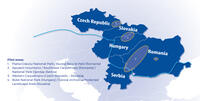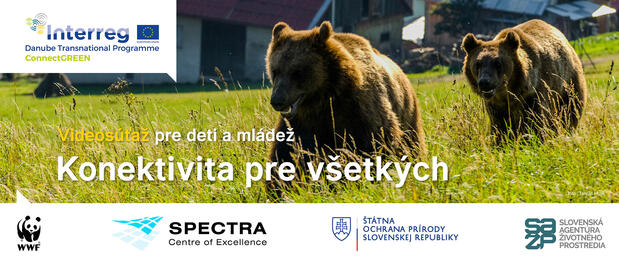ConnectGREEN. Right of way for nature
Restoring and managing ecological corridors in mountains as green infrastructure in the Danube basin.
To access the ConnectGREEN E-Learning Platform, click here.
To access the ConnectGREEN Innovative Decision Support Tool, click here.
To access the ConnectGREEN CCIBIS Geoportal, click here.
The planned infrastructure developments in the Danube-Carpathian region threaten to cut through the movement corridors of large carnivores and increase the fragmentation of their habitats.
Very few spatial planners have the knowledge and experience to ensure that conflicts between development and nature conservation are minimized as they develop new plans. More importantly, legally binding mechanism that takes into consideration the requirements of functioning ecological corridors is poorly implemented — mainly due to the lack of reliable data. These circumstances require a coherent transnational answer as large carnivores frequently move across state borders in search of food and mates.
Through the ConnectGREEN project, partners from different countries and various fields of activity (i.e. spatial data planning, research, government, conservation) have joined forces to increase capacity in ecological corridors identification and to overcome the conflict between infrastructure development and wildlife conservation. As a result, valuable knowledge and experience will be made available to spatial planners for adjusting their new infrastructure plans to ecological connectivity requirements.
Maintaining or restoring ecological corridors will secure viable populations of large carnivores in the Carpathians and preserve one of the largest biodiversity hotspots and functioning ecosystems of the continent. Moreover, this novel joint approach is meant to accelerate the implementation processes and put into practice much-awaited infrastructure developments that face the risk of being delayed due to non-conformity with safety and environmental standards.
Long term solutions for wildlife movements
The main objective of the project is to maintain and improve ecological connectivity between natural habitats, especially between Natura 2000 sites and other protected areas of transnational relevance in the Carpathian ecoregion — namely, in the Czech Republic, Hungary, Romania, Slovakia and Serbia.
Specifically, the project aims to:
→ Develop innovative solutions and guidance to identify ecological corridors and connectivity gaps in a harmonized way across the Carpathian eco-region. This is pursued in order to maintain long-term, cross-border wildlife movement, associated ecosystem services, and a high level of biodiversity in the region.
→ Engage protected area and Natura 2000 site managers, conservationists, spatial planners and other key stakeholders in an integrated approach for strengthening the capacity to identify and manage ecological corridors.
→ Reconcile nature conservation with spatial planning and development in ecological corridors and Natura 2000 sites by identifying and implementing strategic directions and instruments and practices.
The ecological corridors will be identified in more detail by using the new Carpathian-wide methodology in 4 transnationally relevant pilot sites: 1. Piatra Craiului National Park (Romania); 2. Apuseni-SW Carpathians (Romania)/ National Park Djerdap (Serbia); 3. Western Carpathians (Czech Republic - Slovakia) and 4. Bükk National Park (Hungary)/ Cerová vrchovina Protected Landscape Area (Slovakia).
You can support this process by prioritizing biodiversity in the list of environmental criteria, by participating in consultations and by sharing knowledge.
A good start in the area
A 2-year long active engagement in the Maramures/Ivano-Frankivsk/Zakarpatska transboundary region was set to identify and preserve the first ecological network in the area by having concrete data collected from the field by using sound techniques and involving key stakeholders. The work continued in the South-Western Carpathians, where a methodology was developed for the identification of both wilderness and ecological corridors.
Bears 41%
Wolves 30%
Lynxes 28%
THE CARPATHIANS ARE HOME TO SIGNIFICANT PARTS OF
EUROPE’S WILDLIFE
13 Partners
10 Strategic Partners
9 Countries
Project co-funded by European Union Funds (ERDF, IPA)
Overall Budget: 2,462,923.53 Euro
ERDF Contribution: 1,920,592.41 Euro
IPA Contribution: 172,892.55 Euro
Contact-Lead partner (Romania): Cristian Remus Papp, project manager, tel: 0040.745.891.929
Contact-SPECTRA CE (Slovakia): Vladimír Ondrejička, project manager, email: vladimir.ondrejicka (at) stuba.sk
www.interreg-danube.eu/connectgreen



